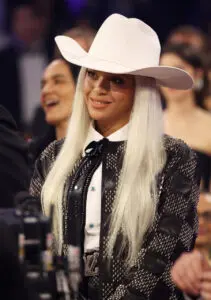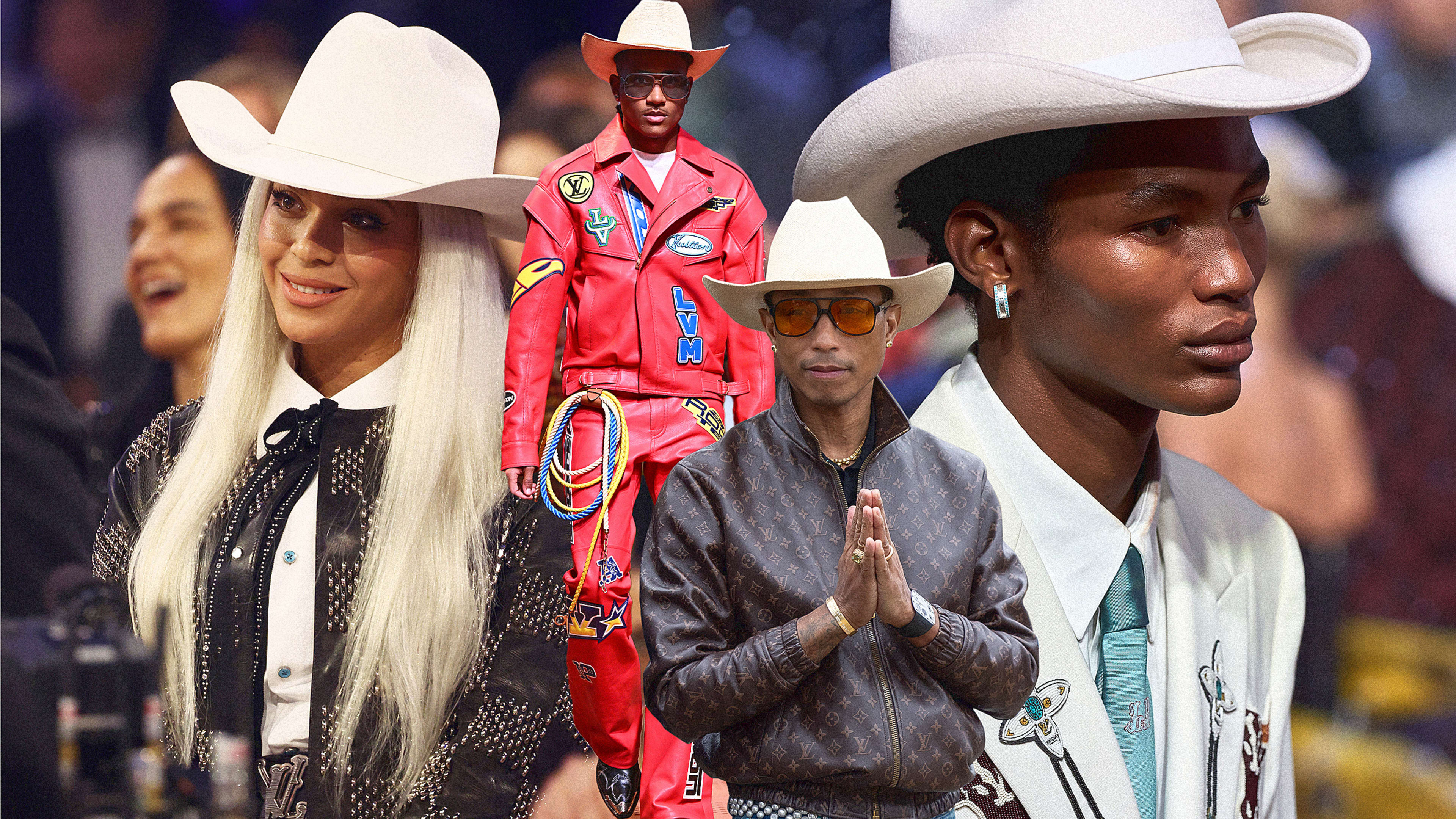Hold your horses. 2024 is gearing up to be the year Black cowboy style hits the mainstream.
In January, Pharrell Williams unveiled his second collection for Louis Vuitton with a runway show in the style of a Western epic that paid tribute to Black cowboys. He invited the Oklahoma Cowboys, a group that represents Black cowboy culture, to model the garments, which included bolo ties, belts with large turquoise-studded buckles, and blazers with cactus and buffalo patches.
In February, Gap collaborated with the legendary Harlem tailor Dapper Dan, famous for remixing European luxury designer looks with a Black hip-hop aesthetic. But with this latest collection, the designer swapped high fashion for Western-inspired pieces like denim button-downs and Oxford shirts embroidered with images of cowboy hats.

And then there’s Beyoncé. During the Super Bowl, she broke the internet when she announced she will be dropping a country record in late March. As someone born and raised in Texas, Beyoncé grew up surrounded by country music, but the two singles she has released from the album are her first to climb the country charts. As perhaps the most powerful fashion influencer in the world, she’s sure to reinterpret the Western aesthetic through her own lens as she drops more content in the months to come.
At first blush, this mash-up of Western aesthetics and Black culture might seem surprising. But experts believe it’s the culmination of a decades-long effort to draw attention to the forgotten history of Black cowboys, who made up a quarter of the cowboys in the American West in the years after the Civil War. As scholars and documentary filmmakers have worked to bring their stories to light, the figure of the Black cowboy is slowly making its way into popular culture. And now it’s bubbling through the fashion world.

Who Was The Black Cowboy?
The cowboy is a uniquely American invention. He’s a symbol of independence, masculinity, and adventure, set against the backdrop of sun-kissed rock formations and desolate valleys in the American West. Most people imagine him to be white. “We don’t picture Black faces out there,” says Zaron Burnett III, a writer and podcaster who has spent years telling stories about Black cowboys and how they intersect with Black identity. Burnett is the son of a Black cowboy and grew up hearing stories of the Black men who went out West in search of freedom.
Roger Hardaway, a historian of the American West at Northwestern Oklahoma State University, explains that in the years after the Civil War, Europeans established ranches in Wyoming, Montana, the Dakotas, and other Western states to produce meat for the growing American population. They needed workers and were open to hiring formerly enslaved people. “They were mostly teenagers who didn’t yet have families, because this kind of work was hard and isolated,” Hardaway says. “But they could make a decent living, because their skills were very valuable, and didn’t face the same kind of oppression as other formerly enslaved people.”
Burnett says that Black cowboys weren’t as poorly treated as, say, sharecroppers in the South. Historical records show that there was some camaraderie among cowboys of different races because they relied on each other to survive under difficult circumstances. But this being America, racism was still present. For instance, the very term cowboy was used as a pejorative to refer to Black ranchers. “A white man doing the same work was called a ‘ranch hand,’” Burnett says.

How The Black Cowboy Was Erased
Learning about the Black cowboys—and his own family’s place within this history—gave Burnett a more nuanced, complex understanding of how Black people fit into the American story. As a child, his father told him bedtime stories about Black cowboys in his own family, along with other famous figures. Barnett learned about Nat Love, one of the most famous Black cowboys, from Love’s autobiography, which documents how he left Tennessee after slavery was abolished to work on a ranch in Kansas. “[My father] wanted me to have a sense that my story as an American is not just tied to slavery, humiliation, and suffering, but also about pride, adventure, freedom, and openness,” Burnett says.
Most Americans haven’t had Burnett’s education. Often our first exposure to the cowboy trope comes from pop culture, perhaps in a Western film starring John Wayne or Clint Eastwood. Many children in the 1950s and 1960s had white cowboy toys, often in conflict with caricatured, vilified Native Americans. Hardaway says that this myth of the cowboy began to emerge in the late 19th century in dime novels, and later in the 20th century in movies. The audiences for both were generally white, so publishers and filmmakers created a fictionalized version of the cowboy that they believed would resonate.
“There was so much white supremacy, particularly in the South, that movie theaters wouldn’t show a movie that had a Black cowboy in it,” Burnett says. “The publishers and moviemakers weren’t interested in educating the public about what really happened. [They were focusing on] making money.”
Over the past few decades, there’s been an effort to correct the narrative. Historians have written a trove of books that delve into the history and lived experiences of Black cowboys. A 2016 museum exhibit in Harlem called Black Cowboy told the history of these people through photographs and videos. And Burnett has a podcast called Black Cowboys on iHeartRadio that delves into this culture.

Black Cowboy Fashion
In the past five years, the concept of the Black cowboy has entered pop culture in new ways. In 2019, Lil Nas X dropped “Old Town Road,” along with a video that featured him on a horse in full cowboy regalia. It was a breakout hit and spurred a conversation about the real Black cowboys of the past. In 2021, Netflix released The Harder They Fall, a highly stylized movie in the genre of a Spaghetti Western loosely based on Nat Love. It featured a Black cast that included Jonathan Majors, Idris Elba, and Zazie Beetz.
The fabulous Black cowboy style seen in music and film is now trickling into fashion proper. Indeed, in 2021, in what could be a prelude to her upcoming album, Beyoncé launched a rodeo-themed collection for her Ivy Park x Adidas line that began to explore the mixing of Western style with streetwear. In many ways, Dapper Dan’s collection for Gap is a similar blend of Harlem street style with traditional Western garments. “We were some of the original cowboys,” he said in a statement to the press about the collaboration. “But we are also the faces of the world to come—we are the urban cowboys.”

In some of these cases, Black designers are using their art to shed light on the history and ongoing culture around Black cowboys. By tapping Black and brown men from the Oklahoma Cowboys for his Louis Vuitton show, Williams was keen to bring some authenticity to the Western looks he had designed. But he also remixed traditional pieces—like cowboy hats and bolo ties—with streetwear, like hoodies and bomber jackets. The final looks convey the Western aesthetic, but don’t look out of place in the modern world.
Burnett says modern cultural explorations of the Black cowboy are in some ways creating a new mythology around cowboy culture. And that’s not a bad thing, because it brings the Black cowboy into the current moment. “It’s important that we allow our imaginations to play so that we allow history to be real and breathe, rather than be stuck in dusty books,” he says. “The way these ideas play out in fashion and art allow us to stay in the emotional reality. It creates a sense of pride, community, and connection.”
But the problem with fashion is that it comes and goes. And Burnett worries that when the trend passes, so too will people’s interest in the real story of Black cowboys. Instead, he hopes that these new cultural touchstones inspire people to learn more about the real historical figures who can help us deepen our understanding of how Black people fit into American history. “Black cowboys helped create America,” Burnett says. “Stories of Black cowboys taught me that I am not a guest in this country. I’m not a problem for America to solve. I’m just as American as anybody else.”
Recognize your brand’s excellence by applying to this year’s Brands That Matter Awards before the final deadline, June 7.
Sign up for Brands That Matter notifications here.
